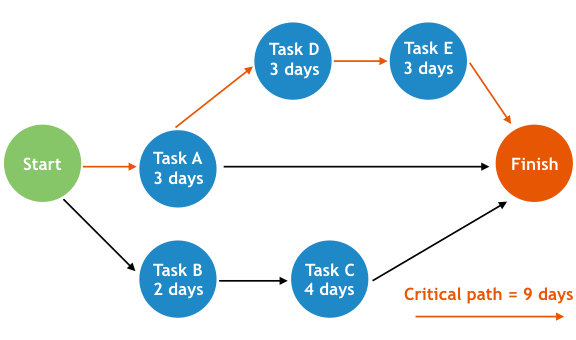Why knowing your Critical Path is a game changer
Critical Path in Project Management
A critical path is a sequence of interdependent tasks or activities. It is the longest path from the project start to the completion. It is also the one that shows the shortest possible length of time in which the project can be completed. If one activity gets delayed, the whole project gets delayed accordingly. Therefore, identification of the critical activities that need to be completed before the project completion is necessary.

Why A Great Project Manager Uses The Critical Path
Listed below are the reasons why a project manager implements the critical path:
Identification of Critical Tasks:
First, CPM helps in identification of the tasks that have to be closely managed. If any of the tasks on the critical path are taking more time than the estimate, begin or finish later than planned, the whole project can be affected.
Reduce Timelines:
When the CPM results are displayed on a bar chart, one can easily see where the tasks are placed in the overall timeframe. You can see the critical path activities along with the task sequences and duration. This gives a new level of insight into your project’s timeline.
Comparison of Planned with Actual:
CPM is popularly used to compare the planned progress with the actual one. The project manager can identify the completed tasks and the pending ones along with the duration needed. As a result, the manager gets an updated schedule and the visual means to compare the planned and actual progress.
Critical Path Method (CPM)
Morgan R Walker of DuPont along with James E. Kelley Jr. of Remington Rand developed the critical path method in the 1950s. Since the start, it aims to address the challenges of managing complex processes and projects.
CPM is a mathematically-based algorithm for scheduling a set of activities. The basic technique for using CPM is constructing a model that includes:
- A list of all the activities needed for project completion.
- The dependencies between the activities.
- The estimate of the time duration for each activity leading to completion.
CPM calculates the longest path of planned activities with these values along with the earliest and latest points of each of the activities from start to finish. And it does so, without making the project longer while determining the critical activities.
Steps to make Critical Path
Listed below are the steps needed for making a critical path in project management:
1. Identify and List all of the activities:
As aforementioned, the critical activities have to be identified. Critical activities are those that cannot be delayed without delaying the whole project.
2. Decide the Order of Activities and Identify Dependencies:
A project manager should identify the dependency and sequence of activities. It is important to identify the activities that can run parallel and those dependent on completion of previous tasks.
3. Draw a Network Diagram:
Previously a pen and paper were used but now a network diagram can be easily made with a project management software. In a CPM activity, each of the activities starts with an event or node and is connected with arrows.
4. Estimate Duration for completion of each activity:
Next, estimate the duration of each activity. This can be easily done by using the information and knowledge of the past.
Identification of the Critical Path:
Following parameters are used for calculation of the longest path after identification of activities with their sequence and their duration.
- Earliest start time (ES) = earliest time an activity can start as long as the previous activity was completed
- Earliest finish time (EF) = ES plus time needed to complete the activity
- Latest finish time (LF) = the latest possible time at which the activity has to be completed, otherwise the project will be delayed
- Latest start time (LS) = LF minus time needed to complete the activity
As END takes the longest time, it is the critical path also, it denotes the minimum time to complete the project. All of the activities on the critical path have an impact on the duration of all other activities. One can speed up the project if the total time of the activities on the critical path is reduced.
Adjustment of the CPM diagram (if needed):
As the completion times of the tasks are estimated in the beginning only, it is essential to update the diagram during the process of the project with the real-time completion times. It is only then you can see whether your project is on the right track.
The Critical Path method might seem a bit complex unless you have actually used it. If you have a good grip on the core project management concepts such as Work Breakdown Structure, you will find it quite simple to use.

An Example of Using CPM Method
Let’s take a simple example of hanging a picture on the wall for a better understanding of critical path method. First, define and list down all the tasks that need to be done for the project completion:
- Select a place on the wall
- Purchase screws
- Choose a picture to get framed
- Drill a hole
- Screw in the screws
- Hang the framed picture
We can see that some of the tasks cannot begin before the others are complete. Some tasks are dependent on others. The actions 4, 5 and 6 form a sequence of the tasks which have to be performed in a particular sequence one right after the other. This ensures a successful result. This kind of activities are called sequential activities.
These three tasks, along with the starting activity of the task are the most critical steps of the project that have to be taken to complete the project.
The essential concept behind the Critical Path Method in project management is that you cannot start some of the activities unless the others are finished in the required sequence.
0 Comments